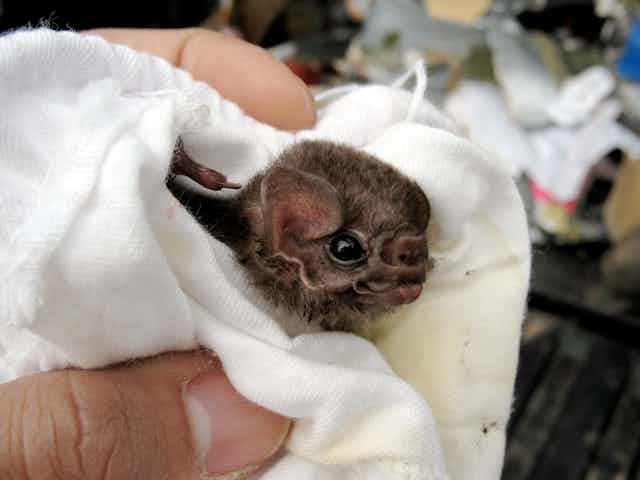What’s for dinner? For some Brazilian vampire bats, these days it’s human blood.
That’s the surprising outcome of my research, recently published in the Acta Chiropterologica journal, which revealed that the hairy-legged vampire bat of Pernambuco, Brazil, has developed an appetite for human blood over that of other possible prey.
This finding upends all the existing scientific literature on this bat species, which typically feeds on bird blood.
A little-known bat (with a secret)
The hairy-legged vampire bat (Diphylla ecaudata) is the least-studied of the three species of known vampire bats. In 20 years working as a zoologist, I had never held a live specimen in my hands.
But there I was in Pernambuco’s drylands in 2013, inside a cave in the Catimbau National Park, when I focused the flashlight on a little colony of bats above my head and spotted a few Diphylla.
Though not the prettiest species of bat, they are more delicate than some, with a gentle face, small ears and, I must say, a soft look.
On the ground below the bats, I saw pools of guano, or bat droppings, each the size of a soup dish. Vampire bats are hematophagous, meaning they can only eat blood, so their excrement is tinged red.

Diphylla prey on bird blood, but in Catimbau Park, native birds of medium and large size have become locally extinct. Probably due to unregulated hunting, the white-browed guan, the yellow-legged tinamou, and the picazuro pigeon — all potential prey for Diphylla in the past — were no longer observed there by 2013.
So what were those Diphylla feeding on, if not birds? Goat blood might make sense. I had seen many grazing in the park, raised by the hundreds of families who still live in Catimbau, despite its legal status as a natural protection zone.
I returned to the Federal University of Pernambuco in Recife, determined to investigate Diphylla’_s_ diet.
The scientific method
Extracting DNA from vampire-bat guano is no small feat. Proteins in their digestive tracts can break down the DNA of the blood consumed, and samples collected in caves can be contaminated with exogenous DNA, either from other organisms in the guano (such as bacteria, fungi and insects) or by the sample collector.
For this task I joined forces with Fernanda Ito, then an UFPE student working toward her undergraduate honours thesis. She liked the idea of using fecal DNA to figure out the bats’ prey as her thesis project. Later our team welcomed Rodrigo Torres, from UFPE’s Department of Zoology, who works with genetics applied to biodiversity conservation.
If all went well, the sequences we obtained would be compared to those deposited in GenBank, indicating the possible prey Diphylla were feeding on.
The process of extracting and purifying the DNA was as long and dramatic as a Brazilian soap opera. For days, Fernanda persistently tested and modified protocols at various temperatures and lengths of time, until finding the right combination that would allow the perfect reaction to happen.
Finally, when Fernanda was on the verge of quitting in frustration, she managed to sequence the samples. When we compared our bat DNA sequences with those obtained from goats, pigs, cows, dogs, chickens and humans, we found that Diphylla had consumed blood from chickens and humans.

At least three samples obtained on different dates pointed to the consumption of human blood. The other 12 of our 15 samples found evidence of Diphylla sucking chickens’ blood.
This was an intriguing finding. Science suggests that Diphylla would never consume human blood. Indeed, three articles (from Mexico in 1966 and 1981 and from Brazil in 1994) even indicated that in captivity, Diphylla would rather starve to death than feed on blood from cows, rats, rabbits, pigs or live goats.
Groundbreaking data
Our data was contrary to all the information available on Diphylla so far. In fact, we had seen reports that indicated that this species actually has a physiological intolerance of mammalian blood, which has more dry matter, mainly proteins, than bird blood (which contains more water and fat).

That would explain why the bats weren’t going after the goats, as I had originally thought. But how to explain the strange preference for human blood?
It seems the scarcity of native large bird species in the park has led Diphylla to develop a more flexible diet than scientists could have imagined. That may be good for Diphylla’s survival, but it’s also an indicator that the area we studied is not faring well. In northeastern Brazil’s dry forests, native species are disappearing, presumably forcing other species, too, to change their diet and behaviour.
The presence of human blood in bat guano also raises public health issues. Clearly, some people in the Catimbau region are being bitten by bats, raising the risk that rabies and other diseases could be transmitted.
On the positive side, Fernanda defended her thesis with success and our article in Acta Chiropterologica is attracting media coverage worldwide.
Discovering that bats can learn to live on human blood has given me several new ideas to explore, such as radio-tracking them to find their human prey.
New research will start soon. Now, I just have to find a new Fernanda …


